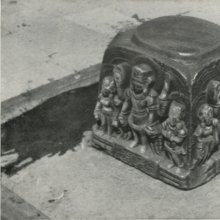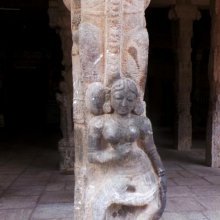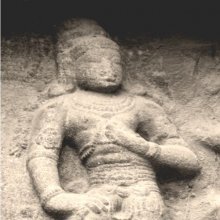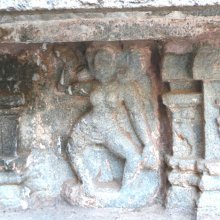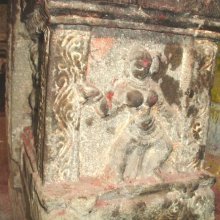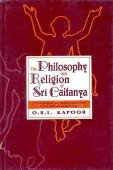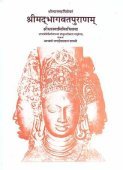Vaishnava, Vaiṣṇava, Vaisnava: 27 definitions
Introduction:
Vaishnava means something in Hinduism, Sanskrit, the history of ancient India, Marathi, Hindi. If you want to know the exact meaning, history, etymology or English translation of this term then check out the descriptions on this page. Add your comment or reference to a book if you want to contribute to this summary article.
The Sanskrit term Vaiṣṇava can be transliterated into English as Vaisnava or Vaishnava, using the IAST transliteration scheme (?).
Alternative spellings of this word include Vaishnav.
Images (photo gallery)
(+11 more images available)
In Hinduism
Natyashastra (theatrics and dramaturgy)
Source: archive.org: The mirror of gesture (abhinaya-darpana)Vaiṣṇava is one of the saṃyutta-hastāni (Twenty-seven combined Hands).
Source: archive.org: Natya ShastraVaiṣṇava (वैष्णव).—A type of standing-posture (sthāna);—Instructions: the feet two Tālas and a half apart, one for the natural posture and another obliquely placed with toes pointing sideways and the shank bent (añcita) and limbs with Sauṣṭhava. Viṣṇu is the presiding deity of this Sthāna.
(Uses): From this Sthāna persons of the superior and the middling types should carry on their ordinary (lit. natural) conversation in connexion with various duties.
Source: Shodhganga: Elements of Art and Architecture in the Trtiyakhanda of the Visnudharmottarapurana (natya)Vaiṣṇava (वैष्णव) refers to “one of the six kinds of standing postures for Men” (in Indian Dramas), according to the Viṣṇudharmottarapurāṇa, an ancient Sanskrit text which (being encyclopedic in nature) deals with a variety of cultural topics such as arts, architecture, music, grammar and astronomy.—Standing postures are determined separately for male and female. In the Viṣṇudharmottarapurāṇa six kinds of standing postures are discussed for men. Standing with easiness by keeping one foot in normal position and other places obliquely is called Vaiṣṇava posture.

Natyashastra (नाट्यशास्त्र, nāṭyaśāstra) refers to both the ancient Indian tradition (shastra) of performing arts, (natya—theatrics, drama, dance, music), as well as the name of a Sanskrit work dealing with these subjects. It also teaches the rules for composing Dramatic plays (nataka), construction and performance of Theater, and Poetic works (kavya).
Shaktism (Shakta philosophy)
Source: Wisdom Library: ŚāktismVaiṣṇava (वैष्णव) is a Sanskrit word for a weapon used in Purāṇic literature, such as the Devī-bhāgavata-purāṇa (9.20.22-53), where it was in the presence of Devī Bhadrakālī, who was preparing for the war between Śankhacūḍa with the Devas.
Source: Google Books: ManthanabhairavatantramVaiṣṇava (वैष्णव) refers to one of the spiritual disciplines (darśana—systems) issued from the limbs of the body of the Goddess, according to the Manthānabhairavatantra, a vast sprawling work that belongs to a corpus of Tantric texts concerned with the worship of the goddess Kubjikā.—[...] All spiritual disciplines, whatever the tradition, are necessarily grounded in the same energy of the Śāmbhava state. They issue, as the texts put it, from the limbs of the body of the goddess who is this energy. These range from the lowest extremity—the left big toe—where Buddhism originates, to the highest—the End of Sixteen—where the Śāmbhava state is attained which is the source of the Kubjikā tradition. The systems (darśana) and their corresponding places of origin in the Goddess’s body are as follows: [4) Vaiṣṇava—the middle of the navel—nābhimadhya, ...].

Shakta (शाक्त, śākta) or Shaktism (śāktism) represents a tradition of Hinduism where the Goddess (Devi) is revered and worshipped. Shakta literature includes a range of scriptures, including various Agamas and Tantras, although its roots may be traced back to the Vedas.
Purana and Itihasa (epic history)
Source: archive.org: Shiva Purana - English TranslationVaiṣṇava (वैष्णव) refers to a “devotee of Viṣṇu” and is used to describe Śiva, according to the Śivapurāṇa 2.3.31 (“Description of Śiva’s magic”).—Accordingly, as Śiva (in disguise of a Brahmin) said to the Lord of Mountains: “O foremost among mountains, I am a Brahmin devotee of Viṣṇu, and a great scholar. My occupation is that of a match-maker. I roam about on the earth. I go where I wish. I go everywhere. By the power of my preceptor I am omniscient. I am simple-minded and by nature I help others and I am sympathetic and quell aberrations. [...]”.
Source: Cologne Digital Sanskrit Dictionaries: The Purana Index1a) Vaiṣṇava (वैष्णव).—A muhūrta of the night.*
- * Brahmāṇḍa-purāṇa III. 3. 43; Vāyu-purāṇa 66. 44.
1b) Eligible for Pārvaṇa śrāddha.*
- * Matsya-purāṇa 16. 9.
1c) The Purāṇa of 23,000 ślokas compiled by Parāśara; he who copies this and makes a gift of it on the āṣāḍha full moon day reaches the world of Varuṇa; gives an account of Varāha kalpa.*
- * Matsya-purāṇa 53. 16-17.
1d) One of the six darśanas;1 the heart of the personified Veda.2
Source: JatLand: List of Mahabharata people and placesVaiṣṇava (वैष्णव) is a name mentioned in the Mahābhārata (cf. III.164.30) and represents one of the many proper names used for people and places. Note: The Mahābhārata (mentioning Vaiṣṇava) is a Sanskrit epic poem consisting of 100,000 ślokas (metrical verses) and is over 2000 years old.

The Purana (पुराण, purāṇas) refers to Sanskrit literature preserving ancient India’s vast cultural history, including historical legends, religious ceremonies, various arts and sciences. The eighteen mahapuranas total over 400,000 shlokas (metrical couplets) and date to at least several centuries BCE.
Vaishnavism (Vaishava dharma)
Source: Prabhupada Books: Sri Caitanya CaritamrtaVaiṣṇava (वैष्णव).—Anyone who is a not a Vaiṣṇava, or an unalloyed devotee of the Supreme Lord, must be a materialist. A Vaiṣṇava living according to Śrī Caitanya Mahāprabhu’s injunctions is certainly not on the materialistic platform. Caitanya means “spiritual force”. All of Śrī Caitanya Mahāprabhu's activities were carried out on the platform of spiritual understanding; therefore only those who are on the spiritual platform are able to understand the activities of Śrī Caitanya Mahāprabhu.
A Vaiṣṇava never agrees with the speculative system of the jñānīs. Both the jñānīs and karmīs depend on direct sense perception for their imperfect knowledge. The karmīs never agree to accept anything not directly perceived, and the jñānīs put forth only hypotheses. However, the Vaiṣṇavas, the unalloyed devotees of the Lord, do not follow the process of acquiring knowledge by direct sense perception or mental speculation.
Source: Pure Bhakti: Bhagavad-gita (4th edition)Vaiṣṇava (वैष्णव) refers to “one in whose heart and mind only Śrī Viṣṇu, or Śrī Kṛṣṇa, resides; a devotee of Śrī Kṛṣṇa. Literally, ‘belonging to Lord Viṣṇu’”. (cf. Glossary page from Śrīmad-Bhagavad-Gītā).
Source: Pure Bhakti: Bhajana-rahasya - 2nd EditionVaiṣṇava (वैष्णव) refers to:—Literally means one whose nature is ‘of Viṣṇu’; a devotee of Śrī Kṛṣṇa or Śrī Viṣṇu. (cf. Glossary page from Bhajana-Rahasya).
Source: Pure Bhakti: Brhad BhagavatamrtamVaiṣṇava (वैष्णव) refers to:—Literally, ‘one whose nature is of Viṣṇu’, in other words, one in whose heart and mind only Viṣṇu or Kṛṣṇa resides; a devotee of Śrī Kṛṣṇa or Viṣṇu. (cf. Glossary page from Śrī Bṛhad-bhāgavatāmṛta).

Vaishnava (वैष्णव, vaiṣṇava) or vaishnavism (vaiṣṇavism) represents a tradition of Hinduism worshipping Vishnu as the supreme Lord. Similar to the Shaktism and Shaivism traditions, Vaishnavism also developed as an individual movement, famous for its exposition of the dashavatara (‘ten avatars of Vishnu’).
Jyotisha (astronomy and astrology)
Source: Wikibooks (hi): Sanskrit Technical TermsVaiṣṇava (वैष्णव).—The nakṣatra, Śravaṇa that is presided over by Viṣṇu. Note: Vaiṣṇava is a Sanskrit technical term used in ancient Indian sciences such as Astronomy, Mathematics and Geometry.

Jyotisha (ज्योतिष, jyotiṣa or jyotish) refers to ‘astronomy’ or “Vedic astrology” and represents the fifth of the six Vedangas (additional sciences to be studied along with the Vedas). Jyotisha concerns itself with the study and prediction of the movements of celestial bodies, in order to calculate the auspicious time for rituals and ceremonies.
General definition (in Hinduism)
Source: WikiPedia: HinduismVaishnava (वैष्णव): A sacrifice performed by Duryodhana in the forest. Yayati, Mandhata, Bharata and others also performed it.
Source: Adbhutam’s blog: Traits of a true VaiṣṇavaIn order to get an idea of the traits of a true Vaiṣṇava one has to look at a sample of the works of the Advaitins, that include Veda Vyasa, Shankara, Madhusudana Saraswati, Appayya Dikṣita, etc. a few of which are presented here.
- The Vaiṣṇava believes that Viṣṇu, under an apparent ignorance, is the one in samsāra.
- The Vaiṣṇava believes that Hari and Hara are non-different; it is One tattvam appearing as two.
- The Vaiṣṇava believes that the upāsana, worship, of any deity of the purāṇic/vedic pantheon leads to liberation through chitta shuddhi since the worship is directed to Brahman that is what is the core of all deities.
- The Vaiṣṇava believes that all lokas, including Vaikunṭha, are not eternal, even in the creation sphere. For the Vaiṣṇava these are subject to pralaya.
- The Vaiṣṇava believes that all attributes, guṇas, of Bhagavan, Brahman, are superimposed by the shāstra on the Nirguṇa Brahman in order to aid the aspirant to reach the goal of securing the realization of the attributeless Brahman.
India history and geography
Source: archive.org: Nilamata Purana: a cultural and literary study (history)Vaiṣṇava (वैष्णव) refers to a system of worship that was once commonly practised in ancient Kashmir (Kaśmīra) according to the Nīlamatapurāṇa.—The popularity of the Vaiṣṇava cult in early Kaśmīra, as indicated by the Nīlamata, is corroborated by the Viṣṇudharmottara Purāṇa mentioning Kaśmīra as a seat of Viṣṇu in the form of Cakrin and by the Rājataraṅgiṇī informing about various temples of Viṣṇu erected by various kings, their relatives and ministers. Raṇāditya, Pravarasena II, Durlabhavardhana and his son Malhaṇa, Gandrāpīḍa, his wife and his preceptor Mihiradatta, Candrāpīḍa’s city-prefect Chalitaka, Lalitāditya and his queen Kamalāvatī and many others are known to have founded shrines of Viṣṇu.

The history of India traces the identification of countries, villages, towns and other regions of India, as well as mythology, zoology, royal dynasties, rulers, tribes, local festivities and traditions and regional languages. Ancient India enjoyed religious freedom and encourages the path of Dharma, a concept common to Buddhism, Hinduism, and Jainism.
Languages of India and abroad
Marathi-English dictionary
Source: DDSA: The Molesworth Marathi and English Dictionaryvaiṣṇava (वैष्णव).—a (S) Relating to viṣṇu. 2 A devotee or follower of viṣṇu.
Source: DDSA: The Aryabhusan school dictionary, Marathi-Englishvaiṣṇava (वैष्णव).—a A devotee of viṣṇu.
Marathi is an Indo-European language having over 70 million native speakers people in (predominantly) Maharashtra India. Marathi, like many other Indo-Aryan languages, evolved from early forms of Prakrit, which itself is a subset of Sanskrit, one of the most ancient languages of the world.
Sanskrit dictionary
Source: DDSA: The practical Sanskrit-English dictionaryVaiṣṇava (वैष्णव).—a. (-vī f.) [विष्णुर्देवतास्य तस्येदं वा अण् (viṣṇurdevatāsya tasyedaṃ vā aṇ)]
1) Relating to Viṣṇu; गां गतस्य तव धाम वैष्णवम् (gāṃ gatasya tava dhāma vaiṣṇavam) R.11.85.
2) Worshipping Viṣṇu.
-vaḥ 1 One of the three important modern Hindu sects, the other two being Śaiva and Śākta sects.
2) Name of the asterism Śravaṇa.
-vī 1 The personified Śakti or energy of Viṣṇu.
2) Name of Durgā.
3) Asparagus Racemosus (Mar. śatāvarī).
4) The Tulasī plant.
-vam 1 The residence of Viṣṇu; i. e. वैकुण्ठ (vaikuṇṭha).
2) The ashes of a burnt offering.
Source: Cologne Digital Sanskrit Dictionaries: Shabda-Sagara Sanskrit-English DictionaryVaiṣṇava (वैष्णव).—mfn.
(-vaḥ-vī-vaṃ) Relating or belonging to Vishnu. m.
(-vaḥ) 1. A follower of Vishnu. 2. One of the modern Hindu sects, (the Vaishnabas, the Saivas and the Saktas are the three important modern Hindu sects.) f. (-vī) 1. One of the Matris, the personified energy or Sakti of Vishnu. 2. A name of Durga. 3. A flower, (Clitoria ternatea.) 4. Sacred basil, (Ocymum sanctum.) n.
(-vaṃ) The ashes of a burnt offering. E. viṣṇu Vishnu, aṇ aff., fem. aff. ṅīṣ .
Source: Cologne Digital Sanskrit Dictionaries: Benfey Sanskrit-English DictionaryVaiṣṇava (वैष्णव).—i. e. viṣṇu + a, I. adj., f. vī, Relating or belonging to Viṣṇu, [Johnson's Selections from the Mahābhārata.] 95, 70; [Rājataraṅgiṇī] 5, 125; [Arjunasamāgama] 4, 30. Ii. m. A follower of Viṣṇu, [Rājataraṅgiṇī] 5, 43. Iii. f. vī. 1. One of the Mātṛs, the personified energy of Viṣṇu. 2. Durgā. 3. A flower, Clitoria ternatea. 4. Sacred basil, Ocymum sanctum.
Source: Cologne Digital Sanskrit Dictionaries: Cappeller Sanskrit-English DictionaryVaiṣṇava (वैष्णव).—[feminine] ī belonging or devoted to Viṣṇu; [masculine] a worshipper of Viṣṇu ([feminine] ī), [neuter] [Epithet] of a lunar mansion.
Source: Cologne Digital Sanskrit Dictionaries: Monier-Williams Sanskrit-English Dictionary1) Vaiṣṇava (वैष्णव):—mf(ī)n. relating or belonging or devoted or consecrated to Viṣṇu (q.v.), worshipping V°, [Taittirīya-saṃhitā] etc. etc.
2) m. [patronymic] [from] viṣṇu [gana] bidādi
3) ‘a worshipper of V°’ Name of one of the three great divisions of modern Hindūism (the other two being the Śaivas and Śāktas; the Vaiṣṇavas identify Viṣṇu rather than Brahmā and Śiva with the supreme Being, and are exclusively devoted to his worship; they have become separated into four principal and some minor sects, as follow: 1. the Rāmānujas, founded by Rāmānuja, who is said to have lived for 120 years [from 1017 till 1137 A.D.] ; his chief doctrines are described at p. 878, col. 1, and in [Religious Thought and Life in India p.119etc.]; one peculiarity of his sect is the scrupulous preparation and privacy of three meals; 2. the Mādhvas, founded by a Kanarese Brāhman named Madhva, whose chief doctrines are described at p. 782, col. 3, and in [Religious Thought and Life in India p.130etc.] 3. the Vallabhas, founded by Vallabhācārya, whose chief doctrines are described at p. 928, col. 3, and in [Religious Thought and Life in India p.134etc.]; 4. a sect in Bengal founded by Caitanya q.v. who was regarded by his followers as an incarnation of Kṛṣṇa; his chief doctrine was the duty of bhakti, or love for that god which was to be so strong that no caste-feelings could exist with it see, [Religious Thought and Life in India p.140etc.] Of the minor Vaiṣṇava sects those founded by Nimbārka or Nimbāditya [Religious Thought and Life in India 146] and by Rāmānanda [Religious Thought and Life in India 147] and by Svāmi-Nārāyaṇa [Religious Thought and Life in India 148] are perhaps the most important, to which also may be added the reformed theistic sect founded by Kabīr [Religious Thought and Life in India 158] and the Sikh theistic sect founded by Nānak [Religious Thought and Life in India 161])
4) Name of Soma (lord of the Apsarasas), [Āśvalāyana-śrauta-sūtra]
5) (śrī-) of a poet, [Catalogue(s)]
6) the 13th cubit (aratni) from the bottom or the 5th from the top of the sacrificial post, [cf. Lexicographers, esp. such as amarasiṃha, halāyudha, hemacandra, etc.]
7) a kind of mineral, [cf. Lexicographers, esp. such as amarasiṃha, halāyudha, hemacandra, etc.]
8) ([scilicet] yajña) a [particular] sacrificial ceremony, [ib.]
9) n. a [particular] Mahā-rasa (q.v.), [Catalogue(s)]
10) a [particular] prodigy or omen (belonging to or occurring in the paraṃ divam or upper sky), [Monier-Williams’ Sanskrit-English Dictionary]
11) the ashes of a burnt-offering, [ib.]
12) Name of the NakṣatraŚravaṇa (presided over by Viṣṇu), [Varāha-mihira’s Bṛhat-saṃhitā]
13) of two Sāmans, [Ārṣeya-brāhmaṇa]
14) of various works., [especially] of the Viṣṇu-Purāṇa
Source: Cologne Digital Sanskrit Dictionaries: Yates Sanskrit-English DictionaryVaiṣṇava (वैष्णव):—[(vaḥ-vī-vaṃ) a.] Relating or belonging to Vishnu. m. A follower of him. f. (vī) A divine energy, Durgā; sacred basil.
[Sanskrit to German]
Sanskrit, also spelled संस्कृतम् (saṃskṛtam), is an ancient language of India commonly seen as the grandmother of the Indo-European language family (even English!). Closely allied with Prakrit and Pali, Sanskrit is more exhaustive in both grammar and terms and has the most extensive collection of literature in the world, greatly surpassing its sister-languages Greek and Latin.
Hindi dictionary
Source: DDSA: A practical Hindi-English dictionaryVaiṣṇava (वैष्णव) [Also spelled vaishnav]:—(nm) a devotee of [viṣṇu]; (a) pertaining to or belonging to [viṣṇu]; hence [vaiṣṇavī] (nf).
...
Kannada-English dictionary
Source: Alar: Kannada-English corpusVaiṣṇava (ವೈಷ್ಣವ):—
1) [adjective] related, belonging, devoted, consecrated to Viṣṇu.
2) [adjective] worshipping Viṣṇu.
--- OR ---
Vaiṣṇava (ವೈಷ್ಣವ):—
1) [noun] one of the three great divisions of modern Hinduism, that regards Viṣṇu as the Supreme Being (the others being Śaiva and Śakta).
2) [noun] a follower or upholder of this division.
3) [noun] a highly powerful mystical weapon the presiding deity of which is Viṣṇu.
4) [noun] a particular standing posture while fighting in a battle-field.
5) [noun] (dance.) a particular standing posture.
Kannada is a Dravidian language (as opposed to the Indo-European language family) mainly spoken in the southwestern region of India.
See also (Relevant definitions)
Starts with (+61): Vaishnava Mantra, Vaishnavabhidhana, Vaishnavacamana, Vaishnavacapa, Vaishnavacara, Vaishnavacarapaddhati, Vaishnavacarasamgraha, Vaishnavacaravidhi, Vaishnavachapa, Vaishnavadasa, Vaishnavadharmamimamsa, Vaishnavadharmanushthanapaddhatau nrisimhaparicarya, Vaishnavadharmanushthanapaddhati, Vaishnavadharmaparva, Vaishnavadharmasuradrumamanjari, Vaishnavadharmavat, Vaishnavadhyanaprakara, Vaishnavadikshapaddhati, Vaishnavagama, Vaishnavagita.
Ends with: Agnavaishnava, Aindravaishnava, Brahmeshavaishnava, Brihadvaishnava, Gaudiyavaishnava, Gomatidasa vaishnava, Karanavaishnava, Parama-vaishnava, Prashnavaishnava, Shaivavaishnava, Shri vaishnava, Shrivaishnava, Tajikavaishnava, Vaidyakashastra vaishnava, Vaidyakashastravaishnava, Viravaishnava.
Full-text (+1697): Shalagrama, Tulasi, Ramanuja, Vaishnavatirtha, Madhva, Vaishnavacara, Vaishnavan, Shrivaishnava, Vallabhacarya, Kanthi, Iramanucam, Buddha, Mamallapura, Pakavatanatanam, Tilaka, Kamthi, Shalagrama-shila, Ashtatacarahasyam, Vaikuntha-perumal, Shaddarshana.
Relevant text
Search found 144 books and stories containing Vaishnava, Vaiṣṇava, Vaisnava; (plurals include: Vaishnavas, Vaiṣṇavas, Vaisnavas). You can also click to the full overview containing English textual excerpts. Below are direct links for the most relevant articles:
Sahitya-kaumudi by Baladeva Vidyabhushana (by Gaurapada Dāsa)
Text 10.217 < [Chapter 10 - Ornaments of Meaning]
The Bible of Sanskrit Poetics < [Introduction]
Text 10.249 < [Chapter 10 - Ornaments of Meaning]
Garga Samhita (English) (by Danavir Goswami)
Verse 1.6.43 < [Chapter 6 - Description of Kaṃsa’s Strength]
Verse 1.7.13 < [Chapter 7 - Description of the Conquest of All Directions]
Verse 1.7.52 < [Chapter 7 - Description of the Conquest of All Directions]
Chaitanya Bhagavata (by Bhumipati Dāsa)
Verse 2.13.93 < [Chapter 13 - The Deliverance of Jagāi and Mādhāi]
Verse 3.2.243 < [Chapter 2 - Description of the Lord’s Travel Through Bhuvaneśvara and Other Placesto Jagannātha Purī]
Verse 1.17.151 < [Chapter 17 - The Lord’s Travel to Gayā]
Bhakti-rasamrta-sindhu (by Śrīla Rūpa Gosvāmī)
Verse 4.3.59 < [Part 3 - Chivalry (vīrya-rasa)]
Verse 4.8.24 < [Part 8 - Compatible & Incompatible Mellows (maitrī-vaira-sthiti)]
Verse 1.2.209 < [Part 2 - Devotional Service in Practice (sādhana-bhakti)]
Shri Gaudiya Kanthahara (by Srila Bhaktisiddhanta Sarasvati)
Amarakoshodghatana of Kshirasvamin (study) (by A. Yamuna Devi)
Religion, Religious Myths and Legends (Introduction) < [Chapter 4 - Cultural Aspects]
Education (10): Knowledge in Archery < [Chapter 4 - Cultural Aspects]
Related products
(+3 more products available)
